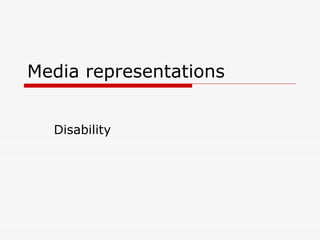
SociologyExchange.co.uk Shared Resource
- 1. Media representations Disability
- 2. Two main ways of understanding and representing disability Medical model Social model
- 3. Medical model ‘views disability as a product of impairment’ (Bulsara, 2005) Focus is on physical difference, e.g. blindness, being wheelchair bound Disabled defined as a group whose bodies do not function normally and are not capable of enjoying a normal lifestyle
- 4. Social model Views disability as the outcome of social barriers Focus is on obstacles and discriminatory practices that those with disabilities face Recognises that some people face impairments, but highlights barriers that exist preventing these people from having an ordinary lifestyle
- 5. Under-representation of disability Content analysis from 1993-2002 shows people with disabilities are shown infrequently, and little has changed In 2002, they made an appearance in 11% of programmes surveyed, but accounted for 0.8% of people that spoke Range of disabilities portrayed was limited – notably related to medical model, specifically blindness and being wheelchair bound (Agyeman, 2003)
- 6. Images of the disabled According to Barnes pitiable and pathetic (1992), there are a an object of violence range of images of the sinister and evil disabled. Content atmosphere or curio analysis of electronic ‘super cripple’ and print media an object of ridicule identified ‘the disabled person as……’ their own worst enemy a burden sexually abnormal incapable of participating normal
- 7. Images of the disabled Range of images identified but the most prevalent ‘commonly perpetuate negative stereotypes’ (Roper, 2003) ‘Three potent images are conjured up: pity, dependent and flawed’ (Bulsara, 2005) For the most part media representations thus ‘represent disabled people as deviant outsiders in clear juxtaposition to the normal and “able bodied” majority’ (Hughes, 1998)
- 8. Images of the disabled Most images show a continuation that the medical model of disability remains most common Campaigners are more vocal and draw on the social model Agyeman (2003) – 42% of disabled people in media are portrayed in relation to ideas of prejudice, discrimination and stereotyping, however it is still rare for disability to be ‘portrayed as an everyday incidental phenomenon’ With ‘disabled people nipping into the Queen Vic for a drink and then leaving again’ (Furner, 2005)
- 9. Ross (1996) Carried out a qualitative study of 384 disabled viewers’ attitudes towards media representations of the disabled Found these disabled viewers were overwhelmingly critical of way disabled characters featured on mainstream television. They objected to:
- 10. Ross (1996) Disabled viewers’ objected to: Infantilization of disabled characters Unrealistic and sanitized portrayal of disability Persistent use of wheelchairs, white sticks and guide dogs to denote disability Associations with disabled roles as anger and bitterness Restricted repertoire of character types Lack of first-hand experience by media practitioners Failure to present disabled people as able to have an ordinary life
- 11. Links MORI POLL http://www.ipsos-mori.com/researchpublications/researcha CREATURE COMFORTS 2007 AD http://www.youtube.com/watch?v=I5gwcAy65Bo CREATURE COMFORTS 2007 BEHIND THE SCENES http://www.youtube.com/watch?v=5cCkhGMISkg DIRECT GOV PAGES http://www.direct.gov.uk/en/DisabledPeople/RightsAndOblig